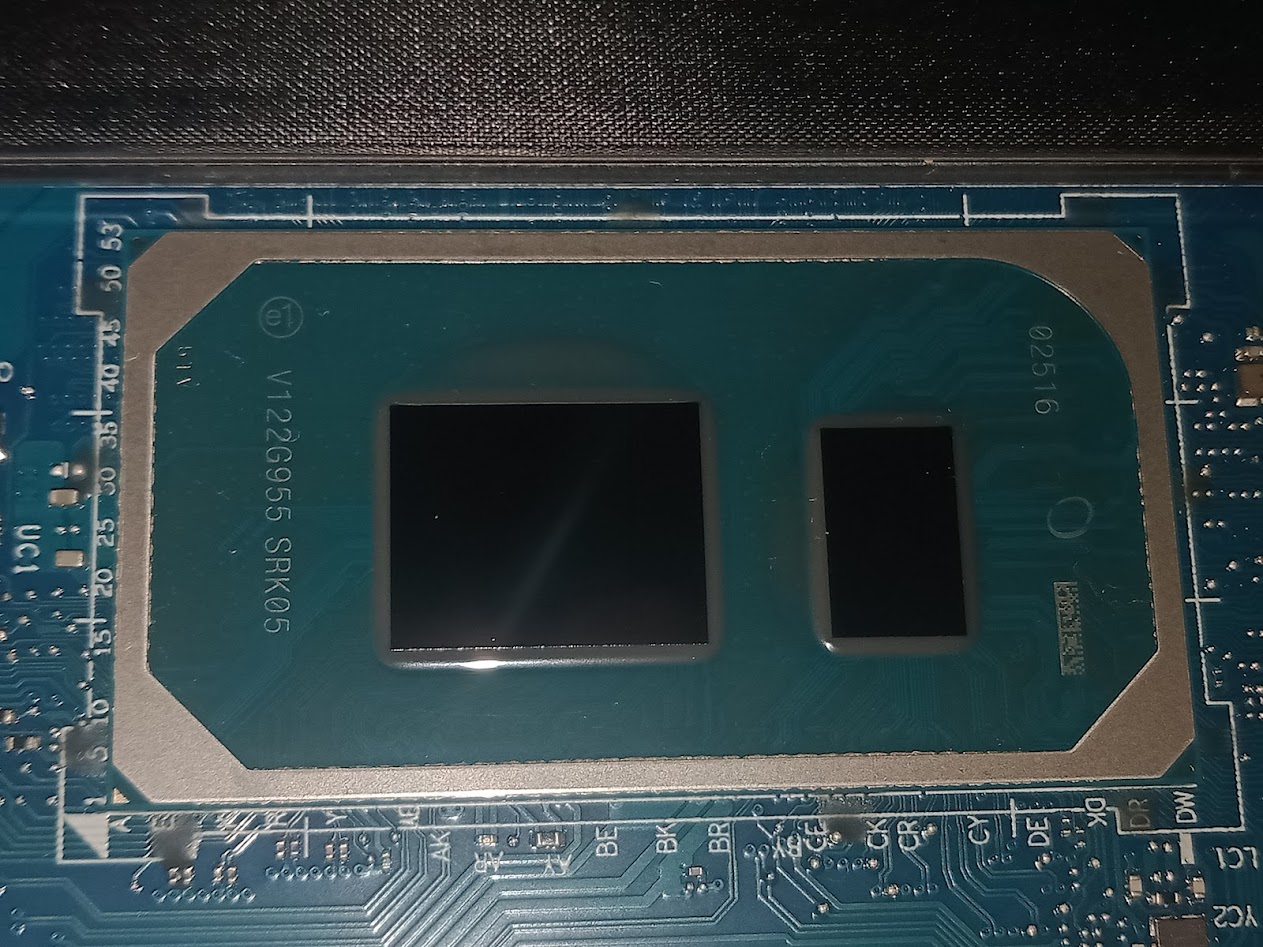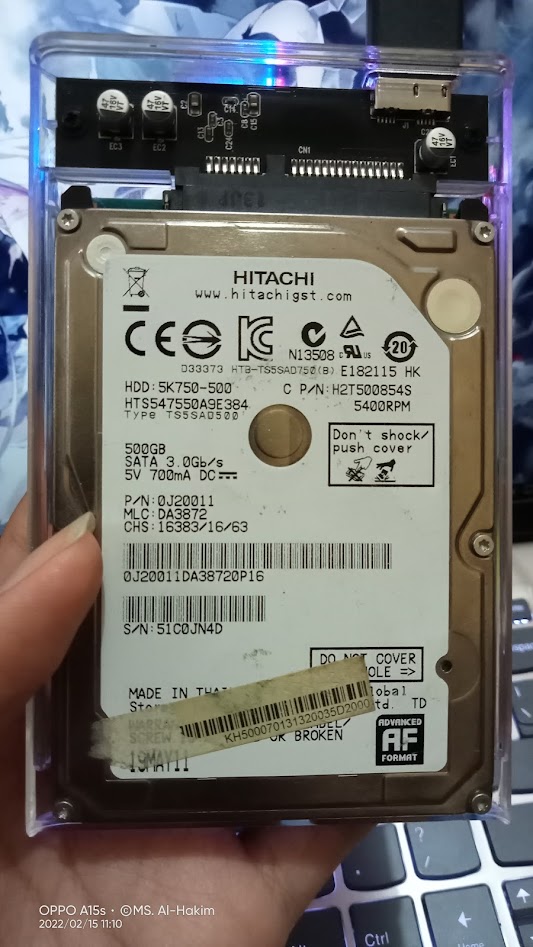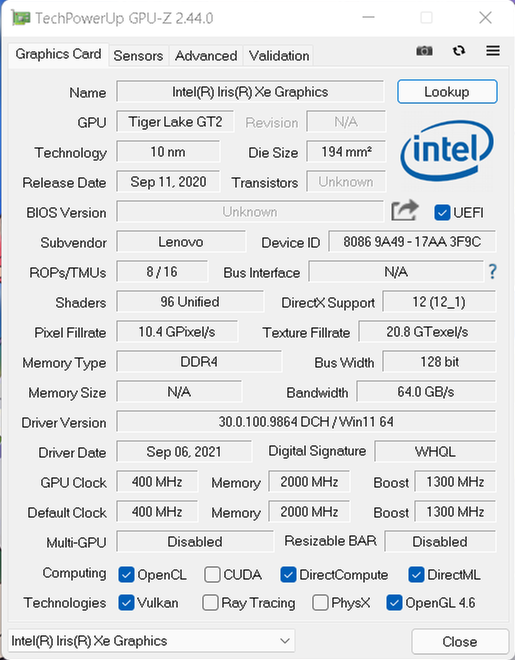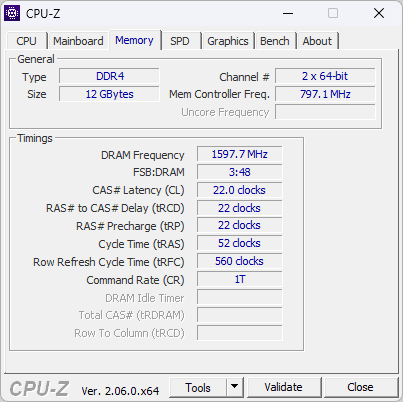Comparing: Intel Iris Xe Graphics (80EUs, Tiger Lake) [Disk] vs Hitachi HTS547550A9E384
In this comparison, we analyze two Disks: Intel Iris Xe Graphics (80EUs, Tiger Lake) [Disk] and Hitachi HTS547550A9E384, using synthetic benchmark tests to evaluate their overall performance. This side-by-side comparison helps users understand which hardware delivers better value, speed, and efficiency based on standardized testing. Whether you're building a new system or upgrading an existing one, this benchmark-driven evaluation offers valuable insights to guide your decision.

Intel Iris Xe Graphics (80EUs, Tiger Lake) [Disk]
| Type: | Disks |
|---|---|
| Model: | Intel Iris Xe Graphics (80EUs, Tiger Lake) [Disk] |
| Capacity: | 2GB |
| Interface: | DDR4 |

Hitachi HTS547550A9E384
| Type: | Disks |
|---|---|
| Model: | Hitachi HTS547550A9E384 |
| Capacity: | 500GB |
| Interface: | SATA-II 3Gbps |
Specification Comparison Table
This specification comparison presents technical details of several devices or components to help you understand the key differences between each option. Use this table as a reference to determine which device best suits your needs.
| Specification | Intel Iris Xe Graphics (80EUs, Tiger Lake) [Disk] | Hitachi HTS547550A9E384 |
|---|---|---|
| Brand | - | Hitachi |
| Format | VRAM Disk | HDD 2.5 |
| Capacity | 2GB | 500GB |
| Interface | DDR4 | SATA-II 3Gbps |
Submission Comparison Table
This submission comparison table displays the number and details of benchmark data submissions from various devices or components. This information helps you understand the performance based on the benchmarks that have been tested, as well as providing an overview of the consistency and popularity of the available benchmark results.
| No. | Benchmark Software | Intel Iris Xe Graphics (80EUs, Tiger Lake) [Disk] | Hitachi HTS547550A9E384 |
|---|---|---|---|
| 1 | CrystalDiskMark |
Read: 2758.52 MB/s Write: 2109.43 MB/s |
Read: 88.66 MB/s Write: 88.06 MB/s |
Submission Comparison Chart
This chart visualizes the benchmark scores comparison between two hardware devices based on submitted data.
Media Gallery
A collection of photos of tested hardware. These images can help you identify the physical form, model, and variant of the hardware in question. These photos are from our own documentation, and if they are not available we may not be able to document them.
About Hardware Intel Iris Xe Graphics (80EUs, Tiger Lake) [Disk]
Intel Iris Xe Graphics (80EUs, Tiger Lake) is the integrated graphics solution (iGPU) of the 11th generation of Intel Core processors, specifically the Tiger Lake series. With 80 Execution Units (EUs) and support for Intel's latest graphics architecture, Iris Xe is capable of delivering significantly better performance than previous generations, including in terms of lightweight graphics rendering, 4K video playback, and casual gaming. Another advantage is its excellent power efficiency as it is directly integrated in the CPU, making it ideal for thin and power-saving laptops.
In this test, Iris Xe Graphics was configured to utilize part of its shared memory as a VRAMDisk. The VRAMDisk concept allows the use of a portion of VRAM-which in iGPUs like Iris Xe comes from the main system RAM-as high-speed storage. While not as fast as physical RAM-based RAMDisks, VRAMDisks on iGPUs still offer very high read/write speeds, mainly due to the optimization of the graphics architecture and the wide memory bandwidth.
The test was conducted on a Lenovo IdeaPad Slim 3i 14ITL6, with an Intel Core i5-1135G7 processor, 12GB DDR4 3200MHz dual channel RAM, and Windows 11 22H2 operating system. Based on data from dxdiag, the dynamically available VRAM reaches 6GB, and in this test, 2GB was allocated as VRAMDisk using GPU RAM Drive software.
Benchmark results from CrystalDiskMark show read speeds of 2758.52 MB/s and write speeds of 2109.43 MB/s. These speeds are significantly higher than SATA SSDs and even close to mid-range NVMe SSDs, making VRAMDisks on iGPUs an attractive experimental solution for temporary data caching, storage performance testing or other specialized scenarios. With a 128-bit bus width and support for 3200MHz DDR4 memory, Iris Xe VRAMDisk shows that even integrated graphics can be creatively utilized for high-speed storage tasks.
Device test (testbed):
Device: Lenovo IdeaPad Slim 3i 14ITL6
CPU: i5 1135G7
RAM: 12GB DDR4 3200MHz Dual Channel (8+4)
OS: Windows 11 22H2
Friday, 06 August 2021 04:34:19 | Update: 1 month ago
About Hardware Hitachi HTS547550A9E384
The Hitachi HTS547550A9E384 is a 500GB 2.5-inch hard disk drive (HDD) designed for laptops, notebooks and portable devices. This HDD belongs to the Travelstar 5K750 line, which is known for its balance between performance, power efficiency and reliability.
Using a 3.0Gbps SATA-II interface and a rotation speed of 5400 RPM, the drive offers good enough performance for daily computing activities such as document storage, multimedia playback, and light operating system installation. Equipped with an 8MB buffer cache, this hard drive provides a stable usage experience, though not as fast as a 7200 RPM HDD.
The Hitachi HTS547550A9E384 comes with a 500GB capacity, enough to store thousands of documents, photos, and multimedia files on a single device. This hard disk uses a 2.5-inch form factor with a SATA-II (3.0Gbps) interface, which is still widely used in older generation laptops. The spinning speed is 5400 RPM, which is not as fast as a 7200 RPM HDD, but it is more power-efficient and quieter in operation.
Underneath the body, this HDD has an 8MB buffer (cache), and consists of two platters and three data-reading heads. The drive is part of the Travelstar 5K750 line, which is known for its durability and efficiency for everyday use, especially in portable devices or laptops with limited power.
To determine its performance, the drive was tested using an HP 1000 1b05au laptop powered by an AMD E1-1200 processor, with a 2x2GB DDR3 1066MHz RAM configuration in single channel mode due to limited dual channel support on the CPU. The drive is mounted via HDD Caddy on the DVD slot and runs Windows 7 operating system.
In tests using CrystalDiskMark, the HDD recorded a read speed of 88.66 MB/s and a write speed of 88.06 MB/s. These results reflect the typical performance of a 5400 RPM HDD with a SATA-II interface, sufficient for standard use such as light booting, file storage, and basic applications.
That's consistent performance with 5400RPM HDDs of this generation and interface. While these drives don't rival SSDs in terms of speed, they are still an ideal power-saving storage solution for devices with battery limitations or legacy devices that still rely on mechanical storage.
Device test (testbed):
Device: HP 1000 1b05au (using HDD Caddy on DVD Slot)
Specs:
CPU: AMD E1-1200
OS: Windows 7
RAM: 2x2GB Single Channel 2 DIMM 1066MHz (Does not support dual channel due to limitations of the CPU, currently running single channel mode and 1066MHz)
Friday, 05 November 2021 02:24:43 | Update: 1 month ago



